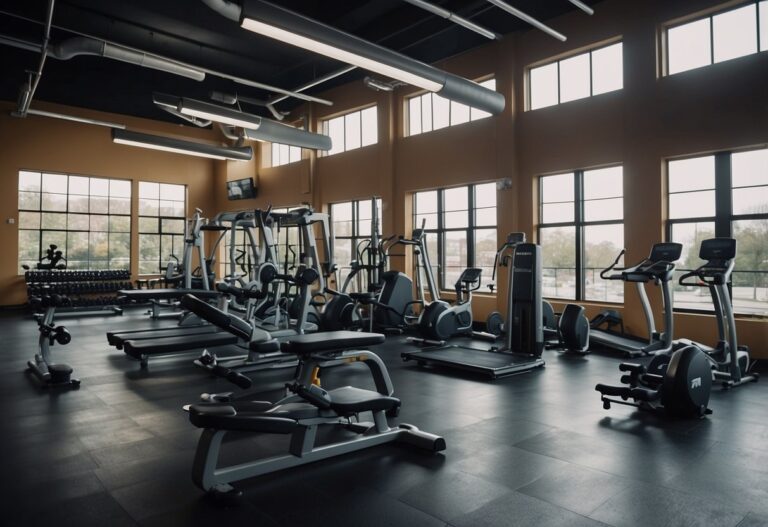A common question that comes up is whether your knee should touch the ground during lunges. Depending on who you ask will dictate what kind of answer you get.
Many physical therapists advocate for the knee to make contact with the ground. Meanwhile, personal trainers and certified coaches often believe it’s unnecessary.
This difference brings up the question of which perspective is correct.
Is Knee Contact with the Ground Recommended During Lunges?
Honestly, there’s no right or wrong answer to this one. It’s pretty much a matter of personal preference.
There are arguments for and against touching your knee to the ground. I’ve always opted to keep my knee off the ground during lunges for many reasons:
Full Range of Motion is Still Attainable
For most individuals, keeping the back knee positioned about 1-3 inches above the ground is sufficient.
This height allows for a good range of motion and helps maintain proper muscle tension during the exercise.
Some advocate for full range of motion, which includes the knee touching down.
However, achieving a 90-degree angle at the knee can be sufficient for many.
Dropping the knee to the floor will reduce this angle.
Remember, focusing on complete movements is key for effective results in strength, muscle-building, or fat loss.
Cheating your reps is only cheating yourself and reducing your gains!

Lack of Control During the Descent
When talking about lunges and knee health, the focus is often on the front knee.
The concern arises when the knee extends past the toes, creating extra stress on the joint.
Some individuals drop their back knee abruptly during lunges, lacking control in the movement.
This uncontrolled descent can lead to potential knee injuries, especially for the back knee.
To mitigate this risk, it’s advisable to perform lunges in a slow and controlled manner.
Also, emphasize proper form over speed.
Time under tension is much more important than explosive power in lunges.
Decreased Muscle Engagement
Dropping the knee to the ground during lunges can lead to muscle relaxation once you hit the floor.
It’s important to perform lunges slowly with a brief pause at each movement change to maximize results.
Try this:
This approach increases time under tension and maintains muscle tension throughout the exercise, benefiting strength training, muscle building, or fat loss goals.
However, completely relaxing when your knee touches the floor divides the lunge into two separate movements, reducing its effectiveness.
While briefly touching the knee to the floor is acceptable, pausing completely eliminates muscle tension and reduces the exercise’s effectiveness.
Hip Flexors Tight or Weak?

It’s best to avoid letting your knee touch the ground during lunges if you have tight hip flexors.
Lunges can be challenging for many due to issues like hip or ankle instability.
Since lunges involve single-leg movement, balance is crucial.
Overstretching the hip flexors during lunges is common but not recommended, especially if you have tight or painful hip flexors.
To maintain proper form, keep your torso slightly leaning forward when performing lunges.
Avoid arching your lower back, as this can strain the hip flexors and hinder the lunge’s effectiveness.
Remember to prioritize maintaining a forward-leaning torso position throughout the lunge movement to prevent overextension of the hip flexors.
Be Careful When Tired
One more reason to avoid letting your knee touch the ground during lunges is due to fatigue.
Whether you’re using weights or just your bodyweight, fatigue can affect your form.
For example, in high-rep bodyweight lunges, fatigue might make you start bouncing your back knee off the ground.
This bouncing movement can strain your knee and lead to injuries. It also makes the exercise easier but reduces muscle tension.
Furthermore, by bouncing off the ground when tired, you lose control over the lunge movement, compromising your form.
Key Takeaways
When it comes to lunges, my advice is to avoid letting your knee touch the ground completely during lunges.
Some trainers may suggest it’s fine, but the ideal scenario is for your knee to lightly brush the ground while keeping proper form.
When performing lunges with a full range of motion, aim to keep your knee 1-3 inches above the ground.
Refrain from forcefully hitting or bouncing your knee on the ground as it indicates a lack of control during the descent.
Allowing your back knee to rest on the floor can lead to a release of muscle tension, which is not conducive to strength and muscle growth.
If you notice a limited range of motion, it could be a sign of tight or weak hip flexors.
Remember to maintain a slight forward lean in your torso while lunging and pay close attention to your form when feeling fatigued.







